| |
introduction
& background information: |
TOP
|
In 1989, Nectaris (a turn-based lunar war strategy game) was
released in Japan
for the PC-Engine (a popular videogame console in yesteryear Japan). NEC
marketed the PC-Engine (PCE) in the U.S. under the TurboGrafx-16
(TG-16) moniker, but the
system quickly faded into obscurity when Sega's Genesis -- which
debuted shortly after TG-16's launch -- gained massive popularity in the
States. Before the demise of TurboGrafx-16, however, American
gamers (well a few, at least) were treated
to some truly fantastic games -- games
that were unavailable on any other
platform. Nectaris was just such a game, and
in 1989 / 1990 it was
re-titled Military Madness and released in North America to the delight of TG-16
|
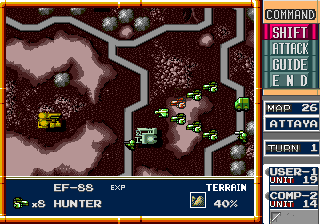 |
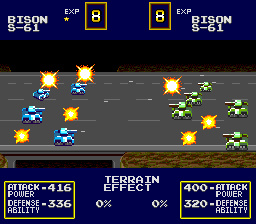 |
|
|
An
overhead, hex-based battle map. |
Battles
are portrayed in scenes like this. |
|
gamers. Military Madness
was easy-to-learn, fun
to play, and tremendously addictive. I don't know if it sold well in the U.S.
(considering the TG-16 itself
didn't sell
well here), but in Japan this game was pretty successful (upon its release, at least
200,000 copies of the Nectaris HuCard were sold, according to this
site). In the second issue of TurboPlay Magazine (dedicated
exclusively to TG-16), they ran their first -- and only -- sales
rankings. While it doesn't surprise me that Bonk's Adventure
was the best seller, I feel bad for all the folks who opted for Takin'
It to the Hoop (a mediocre-to- poor basketball title) over Military
Madness (which ranked tenth). These sales rankings would be much
more useful if we
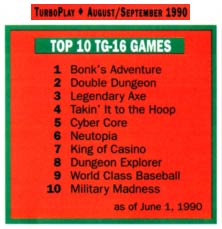
|
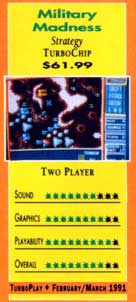
|
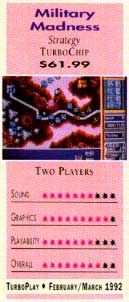
|
|
TurboPlay August /
September 1990 |
TurboPlay Feb / March
1991 |
TurboPlay Feb / March
1992 |
had actual sales figures and
if we knew the total number of games comprising the TG-16 library in June
of 1990. As I already mentioned on the homepage of this site, Video
Games & Computer Entertainment (the most popular multi- platform
video game magazine at the time) bestowed Military Madness with the
"1990 Best Military Strategy Game Award" while Game Player's
Magazine honored it with their "1990 Best War Game
Award". This leads me to believe that Military Madness was
given positive reviews by these publications (please send
me scans of the reviews) and helped stimulate some interest in the
game.
As it turns out, TurboPlay never reviewed or profiled Military
Madness since TurboPlay was launched long after the game had been
released. Still, over its lifespan (1990-1992), TurboPlay offered
two "mini-reviews" for Military Madness in an annual
feature called "TurboPlay Rates the Games." An astute eye
may notice several things about these mini-reviews: (1) the outrageous
$61.99 list price for a TG-16 HuCard, the inconsistent ratings in the
graphics and playability categories, and finally, the first screenshot is
from the U.S. version but the second screenshot is from the Japanese
version. Visit the TurboPlay
Magazine Archives for more information on TG-16 magazines.
The storyline in Nectaris was pretty generic (read about it here)
and there were some very minor differences between the Japanese and North American
versions
(also documented on the aforementioned link).
It would be a full nine years until
the next North American Nectaris release (in 1999, Jaleco brought a
PlayStation update of Nectaris stateside). During the interim, fans of the series had to
resort to importing Nectaris
titles released elsewhere. The series has spanned sixteen years
(1989-2005) thus far and has appeared on numerous platforms: Gameboy,
PC- Engine, TurboGrafx-16, NEC's PC-98
computers, Sharp's X68000 computers, Playstation, IBM-PC, and most
recently -- mobile phones).
|